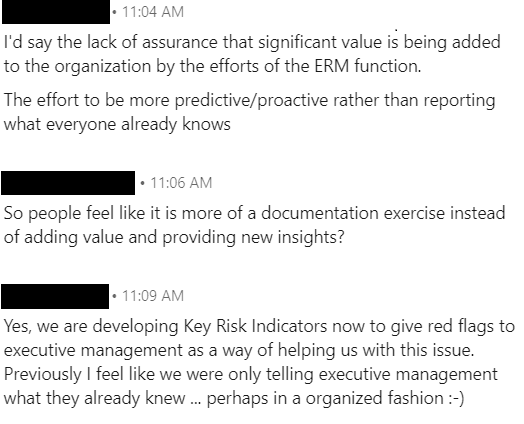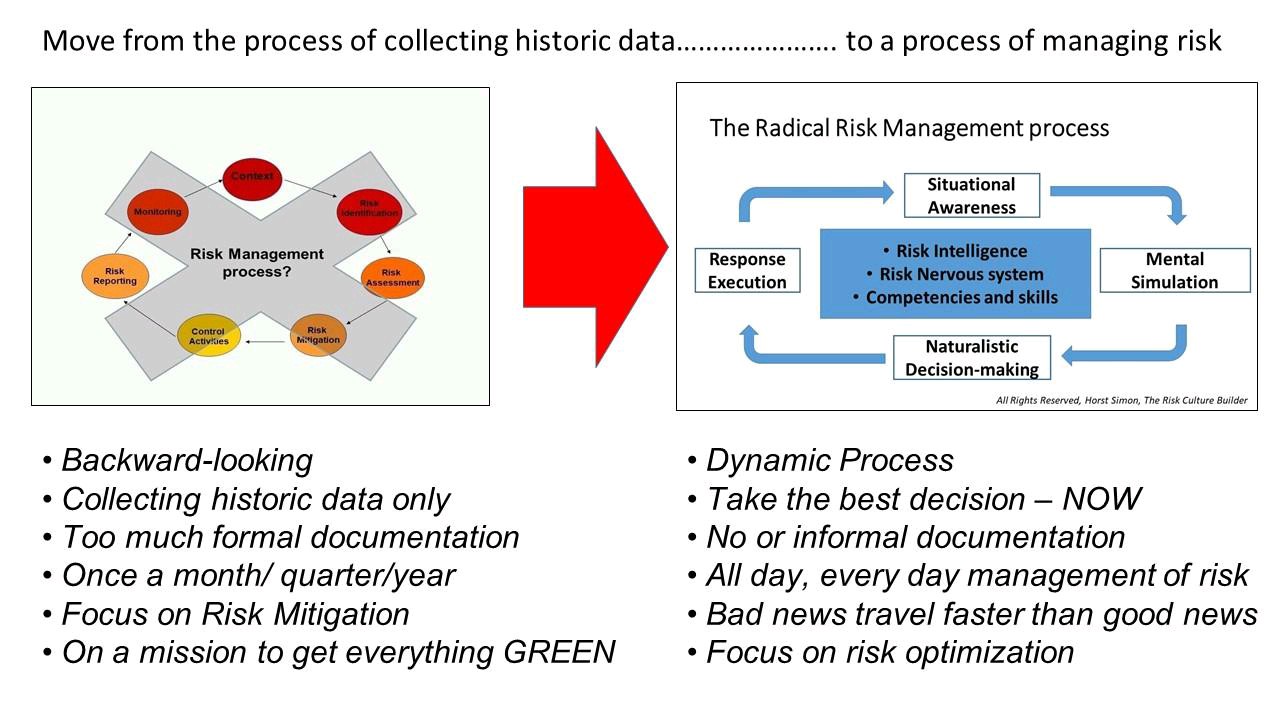Whether driving on the open highway or around town, it’s a good practice to glance in your rearview mirror every minute or two to see what’s following so you can make adjustments if needed.
But could you imagine trying to do the opposite – driving forward but only glancing out the front windshield occasionally?
How long do you think it will be before you end up in a collision? Not very long probably…
However, when it comes to risk management, that’s exactly how many organizations approach it. While a physical wreck with the potential for injury and possibly death doesn’t occur, there is a metaphorical wreck occurring in the form of ERM processes being clunky and outdated, with reports being obsolete the moment they’re completed, among other consequences.
In short, ERM is simply seen as a documentation exercise offering no real competitive advantage to the organization. The annual State of Risk Oversight Report from NC State confirms this yet again with only 12% of respondents claiming their ERM program “mostly” or “extensively” provides this benefit. When discussing this same report in 2020, I explained the reason for this sad fact as:
As long as ‘ERM’ is considered a separate activity from managing the company, executives will continue to see little strategic benefit.
With that in mind, the following graphic from Risk Culture Builder, Horst Simon, caught my eye. The image below captures much of that fact in a nutshell.
Your risk is never under control, live with it. Stop having fancy meetings to sit and discuss for hours whether something should be RED, AMBER, OR GREEN….last month!
This graphic certainly gives a good overview of much of what I’ve been saying in my articles. It’s a great representation of where ERM is for many and where it needs to go for ERM to play a valuable role in helping the company not just avoid failure but achieve goals and succeed.
However, as much as the graphic makes this point, many who are either new to ERM or trying to figure out why their efforts keep coming up short will need a little more to go on than a few pithy (but accurate) bullet points.
With that said, below are some of my previous articles that provide a more background on each of these points, so that your company can shift ERM from always looking at the rearview mirror to helping guide the company through the view out the front windshield.
Keeping with the left side of the graphic…
This conversation with a fellow risk professional a few years ago expresses some frustrations executives have about a rear-facing “documentation” approach to risk management:

Now if your company is subject to regulations like ORSA or is publicly traded, there are some risk-related regulations that will require documentation or historical data referenced on the left side of the graphic. You may be asked how you’re managing a particular risk, so some documentation will be needed. However, as the following article explains, this must be done carefully:
Since any reports or data are usually obsolete in pretty short order with the “rear-view” approach, decisions are usually reactive in nature.
Moving over to the right side of Horst’s graphic…
This is where we get into the interesting stuff, meaning the characteristics of a forward looking approach to risk and opportunity management that meets the needs of companies in today’s volatile world. See the (non-exhaustive) list of articles below for more details on making this a reality for your organization:
- Building a Performance-Focused Risk Management Process Requires a Strong Foundation (Part 1 of a 4-part series)
- Decision Analysis: A Structured Process for Improving Business Decisions
- 4 Simple Steps to a Speedy and Effective Decision
- Don’t Waste Time Managing Risks
- Was the 70s Oil Market a Sneak Peek into our Current VUCA World?
- Working in a Sprint Mentality to Provide Real Insights to the Business
- Should We Still Be Using the Term Risk Management?
- Making Outdated ERM Processes More Adaptable
- Stop Seeing Red: How to Revamp your Risk Assessment Process to Free Up More Resources
- 10 Attributes that Made ERM Successful at the LEGO Group
This of course is just a sampling of how a company like yours can transform its ERM into a helpful partner in the achieving goals rather than a ritualistic check-the-box activity for satisfying regulators.
Are there other resources you would recommend for shifting risk from the rear-view mirror to the front windshield?
We’re interested in hearing your thoughts, so please don’t hesitate to leave a comment below or join the conversation on LinkedIn.
And if your company remains stuck looking at risk in the rear-view mirror instead of out the front windshield and can’t seem to make that transition, please feel free to reach out to me today to discuss your specific situation and potential paths forward.









